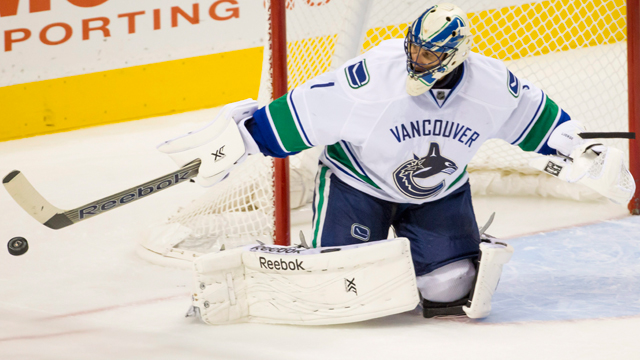One of the difficulties assessing goaltenders is separating perception from actual performance. Perception can be driven by data—a high save percentage equals a great goaltender. It can also be driven by great playoff performances that result in the “clutch” label, which can even get you into the Hall of Fame.
The problem is that perception can sometimes be contradicted by the things that drive it. James Reimer has had three seasons of .920-plus save percentage performances. In his one playoff appearance he put up a .924 save percentage, yet this data is nullified by a nine-minute stretch last spring that ended in an historic loss for the Maple Leafs.
It is one of the reasons why I am skeptical about relying heavily on experience when choosing an Olympic goaltender. I do not doubt or object to it being important, but I don’t think it is more important than recent performance. I don’t quite understand the hierarchy of assessing it’s worth.
Roberto Luongo is going to make Team Canada based on reputation and experience. He has an Olympic gold-medal and knows how to win. But that reputatation is easily contradicted when it comes to his playoff performances against the Chicago Blackhawks or his Stanley Cup Final meltdown. Marc-Andre Fleury won a Stanley Cup and made one of the most memorable clutch saves in recent Cup history, but that experience hasn’t been able stop a flurry of goals in recent playoff games. Since that save in 2009, Fleury has an .880 save percentage through 809 playoff shots.
Experience hasn’t even played a large factor in Olympic goaltending success. Jim Craig didn’t have the Olympic resumé of Vladislav Tretiak in 1980. Martin Brodeur had never started an Olympic game entering 2002. Henrik Lundqvist had zero Olympic and just 40 NHL games under his belt when he arrived in Turin in 2006. I can’t quantify how many save-percentage points experience is worth because its assessment is flawed and open to biased interpretation. Reputations don’t stop pucks, just ask Brodeur in 2010.
Based on save percentage alone, Reimer—who is struggling to maintain his hold on the Maple Leafs blue ice—has the strongest argument for Sochi, but will it hold up to the fine tooth comb of the Shot Quality Project?
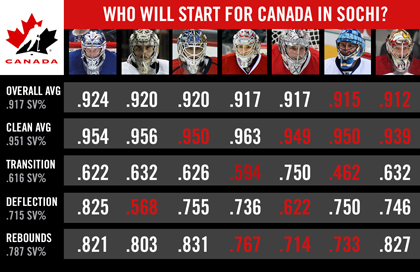
*red indicates below the group average
Since the lockout Reimer has the best save percentage among the contenders and also the only above-average mark in every individual category of the shot quality project. Luongo should be red flagged as in decline as he approaches his 35th birthday. I reviewed each individual goaltender from the lockout-shortened 2012-13 season into late November. I used a similar manner to my previous assessments of Price, Rask and Reimer, assessing each individual goaltender against the results of the final seven contenders. I created an expected save percentage based on their average results and recalculated their save percentages based on an easier or more difficult workload.
MIKE SMITH
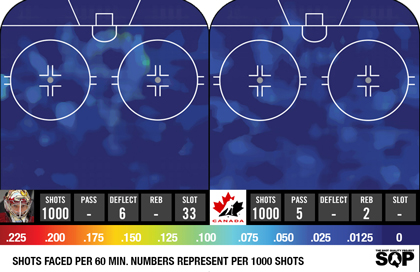
*numbers represent the differential between workloads
One of the challenges of the SQP is being able to understand the context of the data. Every Benoit Allaire goaltender I have reviewed has a similar profile based on their systematic approach to the position. Smith is no different. He is strong on rebounds and because of his size can reduce the damage caused by deflections. By setting up deep in his crease he reduces the distance to travel on cross-crease transitions. The problem with the style, though, is highlighted by his .939 save percentage on clean shots. This lower number can be attributed to more slot opportunities than the average contender has faced, but it comes with the danger of playing deep. This low conversion rate concerns me on a Canadian team that needs its netminder to manage the crease and not self destruct. Luongo was the only goaltender worse than Smith at conceding goals outside of the home plate area. Twenty-five percent of the Phoenix netminder’s goals allowed came from outside and in a short tournament that could send Canada home earlier than expected. Smith is out.
COREY CRAWFORD
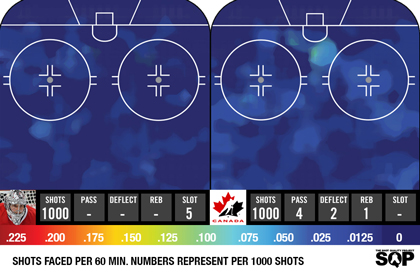
*numbers represent the differential between workloads
A Stanley Cup on your resumé will get you included in this conversation, but Crawford’s work before and after last season is suspect. When I compared his career against the league average, Crawford was red flagged. He was exposed as a goalie with an easier workload but inferior results. When his statistics were adjusted for his workload, his save percentage dropped from .917 to .914. Could he game-manage enough of a performance for Canada to win in Sochi? Possibly. He did a strong Chris Osgood impression last spring, but with better options available, Crawford gets to stay home and work on his glove hand.
MARC-ANDRE FLEURY
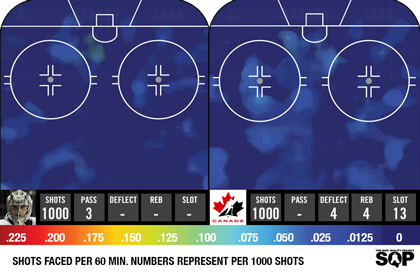
*numbers represent the differential between workloads
Fleury offers an extreme struggle when it comes to perception versus reality. The SQP tracks neutral zone dump-ins, which register close to a 1.000 save percentage, except when this happens. When you include the circus show of his past four playoffs, it is hard to fight off the preconceived notions. Fortunately, Fleury’s data didn’t force me to fight that titanic battle. He has been pretty good since the lockout, but has also been well protected. He is quick and athletic, but is also a puck chaser and that gets him into trouble at times. Out of all the goaltenders I have reviewed, he has been the author one of the most bizarre goals I have seen .
If I am looking to make a high-risk/high-reward bet in Sochi, I may go with Fleury, but that is the exact opposite of what Canada needs. I don’t trust his over-aggressive style and his data isn’t good enough for me to get past that feeling.
ROBERTO LUONGO
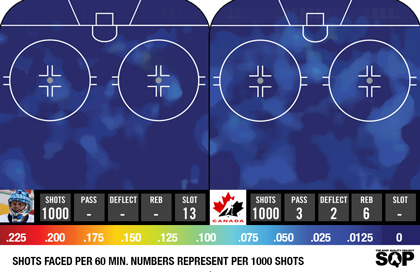
*numbers represent the differential between workloads
This was a tough choice because experience is hard to quantify. Luongo’s recent injury muddies the waters some, but since the lockout he has performed the worst among the Canadian finalists. But 2012-13 was a very small sample and he has recently rebounded from a slow start to place himself above league average.
Is he in decline or is it just a small sample outlier?
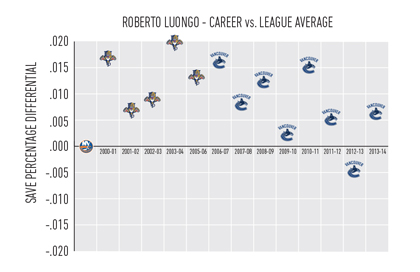
The above chart shows some downward decline, but last season was also the only one in which Luongo performed under the league average. When we cross-reference that performance with previous studies of goaltenders aging, it paints Luongo as a netminder whose best days are behind him.
When put under the microscope, the SQP identifies Luongo as underperforming in his defensive coverage. His lateral movement is already behind the current generation of netminders and he is the only goalie I have reviewed who is below .500 on transition passes. The heat maps show a goaltender who has been protected from the home plate area in relation to his Canadian peers, yet he still has surrendered the most goals from the perimeter.
When I adjusted his save percentage against his peers, the argument for Luongo got even worse. He outperformed the average amongst his peers in only one of five categories.
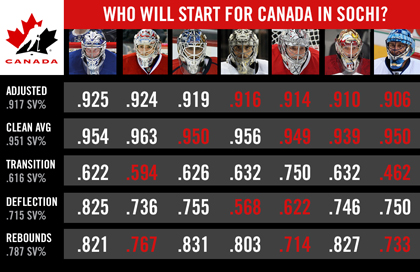
*red indicates below the group average
Team Canada’s third goaltender has never played a minute of Olympic competition. I could make a strong practical argument that even if 2012-13 wasn’t just an outlier season and he is as bad as the data indicates, there remains a trap door where Luongo puts on a Team Canada baseball hat, offers advice, entertains all of us on Twitter and high fives the crap out of Carey Price. But I want individuals who I am confident can step into an important situation and succeed—the three best Canadian goaltenders in the NHL. Strombone stays home.
SOCHI BOUND
The final three fight against the conventional wisdom because the most experienced of them is only 26 years old, but all three make my team on the merits of their performances and not perception or post-prime experience.
BRADEN HOLTBY
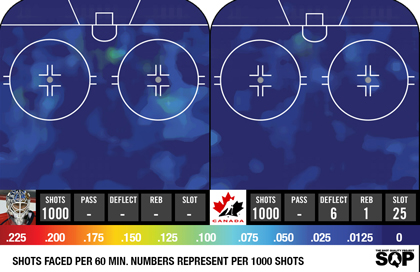
*numbers represent the differential between workloads
Holtby will likely be overlooked in the final conversation because of a lack of experience, but he has been among Canada’s best since he made his Hockey Night in Canada splash during the 2012 playoffs. When I normalize the workload, Holtby grades out as a goaltender who is exactly where he is supposed to be. His success hasn’t been driven by team performance. He grades out above average in every category except for clean shots, where he is one goal worse than average per 1,000 shots. He has the ability to steal wins while not offering up the lows of somebody like Fleury. The biggest concern surrounding Holtby is just 2,500 shots of NHL experience. I would bring him to Sochi as a guy who could slot in between Nos. 2 and 3, likely landing him a Pert Plus endorsement contract.
JAMES REIMER — BACKUP
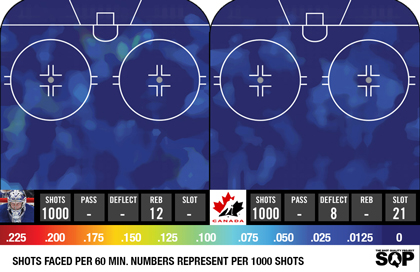
*numbers represent the differential between workloads
Reimer may not be good enough to start for the Maple Leafs, but he can play for my Team Canada. He graded above average in every category and still struggles to gain respect among his own fan base to the point where the only criticism that can be tossed at him is poor rebound control. Reimer has been dominant on rebounds and we can see by the heat maps that he has been exposed in the highest goal-scoring areas. He also has begun to compile a larger resumé of success and the outlier has begun to look like his injury plagued sophomore season, not his recent performance.
Like Holtby, Reimer’s normalized results showed a slight improvement on his actual performance. He has been lights-out for the majority of his brief career, but it wasn’t enough to move him into the starter’s role.
CAREY PRICE — STARTER
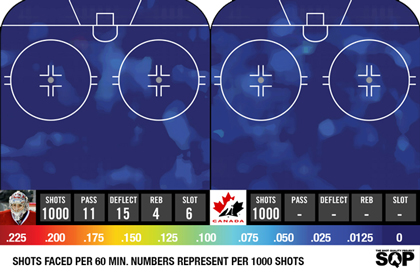
*numbers represent the differential between workloads
When assessing Price’s workload it became clear that he has been fighting an uphill battle to register an elite save percentage. He is facing 30 fewer clean shots per 1,000 attempts than his opponents, but still managing to register an above-average performance. On a team like Canada, a goaltender with a .963 save percentage on shots he can set and see is a huge asset. Reimer still grades slightly ahead in save percentage during the most recent span, but fortunately I have a larger sample of comparison between Price and Reimer to determine who should start in Sochi.
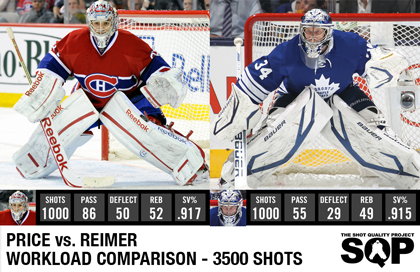
*numbers do not include phantom shots recorded by nhl.com
If we contrast their workload over Reimer’s full career and Price’s past 3,500 shots, we get comparable save percentages, but Price has to deal with a more difficult workload. If I do the same thing I did with the Olympic contenders and create an expected average workload the numbers like this this:
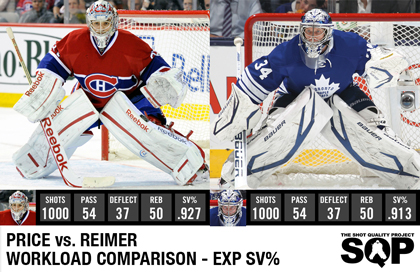
Reimer remains around the elite Canadian goaltender level even with his terrible 2012-13 included. Price takes himself to the elite level when given a respectable level of defensive support. Carey Price’s world junior MVP pedigree doesn’t even need to enter the conversation. He is among the best in the world; not just a possible Sochi candidate, but s lock.
Canada doesn’t have a goaltending problem. Rather, it’s a strength led by three young goaltenders in or entering their primes: Price, Reimer and Holtby.
